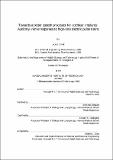Towards a better speech processor for cochlear implants : auditory- nerve responses to high-rate electric pulse trains
Author(s)
Litvak, Leonid, 1973-
DownloadFull printable version (1.867Mb)
Other Contributors
Harvard University--MIT Division of Health Sciences and Technology.
Advisor
Bertrand Delgutte and Donald K. Eddington.
Terms of use
Metadata
Show full item recordAbstract
Cochlear implants are prosthetic devices that seek to restore hearing in profoundly deaf patients by electrically stimulating the auditory-nerve (AN). With current implants, the representation of the sound waveform in temporal discharge patterns of the auditory nerve is severely distorted. The distortion is particularly significant at higher (>600 Hz) frequencies, for which the period of the electric stimulus is near the AN refractory period. For example, in response to a 1000-Hz pulse train, most AN fibers may fire on every other stimulus cycle, so that the AN population would represent half of the stimulus frequency rather than the actual frequency. Rubinstein et al. [Hearing. Res. 127, 108] proposed that the coding of electric waveforms in cochlear implants can be improved if a sustained, electric high-rate (5 kpps) desynchronizing pulse train (DPT) is presented in addition to the information-carrying electric stimulus. The DPT may amplify the inherent noise in ANfibers so as to produce ongoing, stochastic discharges similar to the spontaneous activity in a healthy hear. We tested this hypothesis by recording responses of ANfibers of deafened cats to sustained electric pulse trains. For most fibers, responses to the DPT showed adaptation during the first 2 minutes, followed by a sustained response for the remainder of the 10-minute stimulus. These sustained responses partially resembled spontaneous activity in terms of discharge rate and interspike interval distributions. AN fibers were extremely sensitive to modulations of the DPT, responding tomodulations as small as 0.5%. (cont.) Responses to sinusoidal modulations resembled AN responses to pure tones over a 15-25 dB range of modulation depths. Responses to complex modulations simultaneously represented several spectral components of the modulator in their temporal discharge patterns. However, for modulation depths above 10%, the representation of both sinusoidal and complex modulators was more distorted. These results demonstrate that strategies that incorporate a DPT, and that use low modulation depths to encode sounds, may evoke AN responses that more accurately represent the modulator in their temporal discharge patterns. If the central nervous system can utilize this information, then these strategies may substantially improve performance enjoyed by cochlear implant users.
Description
Thesis (Ph.D.)--Harvard--Massachusetts Institute of Technology Division of Health Sciences and Technology, 2002. Includes bibliographical references (p. 169-184). This electronic version was submitted by the student author. The certified thesis is available in the Institute Archives and Special Collections.
Date issued
2002Department
Harvard University--MIT Division of Health Sciences and TechnologyPublisher
Massachusetts Institute of Technology
Keywords
Harvard University--MIT Division of Health Sciences and Technology.